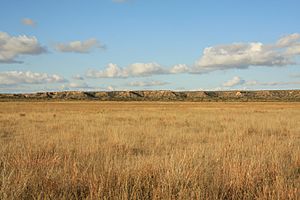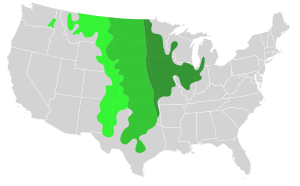Shortgrass prairie facts for kids


The shortgrass prairie is a special natural area. It is found in the Great Plains of North America. This prairie stretches from the eastern foothills of the Rocky Mountains all the way to Nebraska. It also goes north into Saskatchewan, Canada. You can find parts of it in Alberta, Wyoming, Montana, North Dakota, South Dakota, and Kansas. It also reaches south through the high plains of Colorado, Oklahoma, Texas, and New Mexico.
Long ago, huge herds of American bison helped keep this prairie healthy. They are a very important animal for this area. The two main types of grasses here are blue grama (Bouteloua gracilis) and buffalograss (Bouteloua dactyloides). Other grasses like greasegrass (Tridens flavus) and sideoats grama (Bouteloua curtipendula) also grow here. The shortgrass prairie does not get as much rain as other prairies. This is because it has a semiarid climate, which means it's quite dry.
Contents
History of the Shortgrass Prairie
People have lived in the shortgrass prairie for a very long time. Native American tribes like the Kiowa, Comanche, and Arapahoe lived here. They hunted bison and pronghorn for food. Sometimes, they would go to the nearby Rocky Mountains to hunt. These tribes often used fire to manage the prairie. They would create "fuel breaks" to stop wildfires. These breaks were areas with no plants or other things that could burn. Rivers, lakes, or canyons could also act as natural firebreaks. These fires also helped new grass grow, which attracted large plant-eating animals.
Later, European explorers and traders came to the shortgrass prairie. They started businesses that used the land's resources. In the mid-to-late 1800s, railroads made it easier for people to move here. More people settled in small towns and rural areas. As more people arrived, large-scale cattle and sheep ranching grew. Later, people also started mining for gold, silver, and copper.
The Dust Bowl Era
In the 1920s, a weather pattern called El Niño brought more rain to the shortgrass plains. This helped crops grow very well. Farmers bought new, better equipment to plant more crops. They plowed up the native land, which left the soil exposed. But by the 1930s, the weather changed. There was not enough grass to protect the soil. This unprotected soil was easily blown away by strong winds. This caused the terrible Dust Bowl dust storms.
Protecting the Prairie Today
Today, much of the shortgrass prairie is used for grazing farm animals. People living here still depend on agriculture. However, there's also more activity in energy and mining. Over time, many animal and plant species have decreased. But people in the region are now working hard. They are using good land management practices. This helps protect the native species, natural communities, and ecosystems.
Climate of the Prairie
The shortgrass prairie is a long, narrow area. It stretches from the top of the country to the bottom. So, the weather changes from north to south. But it stays mostly the same from east to west. The northern parts are much colder than the southern parts. Also, there is more precipitation in the south and to the east.
Unlike the tall and mixed grass prairies, the shortgrass prairie has a summer drought. This dry period lasts one to two months. This makes it the driest of the three prairies. This region also experiences many hailstorms, blizzards, tornadoes, and dust storms.
People and the Prairie
Two main things are happening with the people living in the shortgrass prairie. First, the number of people in the region is going down. Many people are moving to the west. Second, more people are moving to metropolitan areas, which are big cities. About three-quarters of the people in this region now live in these cities.
Most people still rely on agriculture. But jobs in energy exploration and mining are becoming more common. More people and new activities have changed the ecosystem. There are fewer types of animals and plants, and their numbers have decreased.
What the Prairie Provides
Growing Crops
A lot of the central grasslands in the United States are used for farming. The shortgrass prairie has a lot of potential for the economy. About half of the shortgrass prairie is still natural. This prairie is great for growing crops. The main crop grown here is wheat. Other important crops include maize, soybeans, and cotton.
Raising Animals
The dry grasslands of the shortgrass prairie are good for raising livestock. Farmers often raise cows and calves. The young animals are then sold to be fattened up. How many animals can be raised depends on the amount of rain. It also depends on the condition of the land and other environmental factors.
Art and Inspiration
Some parts of the shortgrass prairie are still untouched and beautiful. Many artists and photographers come here for ideas. They also find ways to make money from their art. Paintings and photos of the prairie are often sold for high prices. The Dust Bowl era also brought many artists and photographers to this area. They hoped to become famous and find work.
Where is the Shortgrass Prairie?
The shortgrass prairie is on the western side of the Great Plains. The Colorado Rockies are to its west. The mixed grass prairie is to its east. It's hard to draw exact lines for the prairie's edges. This is because plant communities change over time.
Generally, the prairie reaches the eastern part of the Rocky Mountains in the west. It goes up to Canada in the north. It extends as far as Nebraska to the east. And it goes into parts of Texas to the south. These are the general areas where you can find the shortgrass prairie.
Protecting the Shortgrass Prairie
In Colorado, a large part of the shortgrass prairie is found. But there are no specific laws to protect this natural area. More than 85% of the prairie is privately owned. It is used for farming, especially for wheat, corn, soybeans, and alfalfa. About half of the original prairie still exists. However, its future protection is not certain. Cities are growing, which will likely continue to affect the prairie. Climate change has less impact here than in other parts of Colorado. This is because the land is lower. But it can still affect the prairie.
Groups Helping the Prairie
- Prairie Dog Coalition: This group is made up of scientists, organizations, and people who care. They work to protect prairie dogs and their homes. They teach people about the decreasing numbers of prairie dogs. They also get involved in projects that might harm prairie dog habitats.
- Southern Plains Land Trust: This group creates and protects areas of shortgrass prairie. Their goal is to make sure all native animals and plants in the region have a future. By 2019, they protected over 25,000 acres of land.
The Prairie Ecosystem
The shortgrass prairie used to be home to huge herds of bison and pronghorn. There were also many large prairie dog colonies. Deer and elk lived here too. Predators like gray wolves and grizzly bears roamed the land. The prairie had healthy populations of blue grama grass. It was also full of songbirds and raptors. There were fields of buffalo grass and many different wildflowers and butterflies. It was so full of life, people compared it to the Pampas in South America.
Today, the most common animal on the prairie is domestic cattle. The shortgrass prairie is used to animals grazing. So, the pressure from grazing animals does not harm it. Pronghorn and prairie dogs still live here, but in smaller numbers. Coyotes have replaced the top predators.
Big natural processes like climate, fire, and grazing are very important here. Sadly, the shortgrass prairie has suffered the most damage of any major natural area in North America. Historically, three main things shaped the prairie: animals eating plants, dry periods, and fires. Now, human activities have caused problems. These include destroying habitats, removing native plant-eaters and predators, spreading harmful weeds, and changing fire patterns.
Flora: Plants of the Prairie
The shortgrass prairie has different kinds of plants. The most common grasses are blue grama (Bouteloua gracilis) and buffalo grass (Bouteloua dactyloides). These grasses form thick mats. Galleta grass (Hilaria) is also present but less common. These grasses are native to the shortgrass prairie. This means they can handle dry weather and grazing animals.
Not many different types of plants grow in shortgrass prairies. This is because the amount of rain and temperature can change a lot each year. Two main plants that do well here are soap weed yucca (Yucca glauca) and plains prickly pear cactus (Opuntia). In years with more rain, wildflowers bloom in the spring. But they quickly disappear in the hot, dry summer months.
Fauna: Animals of the Prairie
The shortgrass prairie is home to many birds, reptiles, and mammals. Most of these animals have learned to live in open areas. Many have adapted to live underground. Others travel long distances to find shelter.
Birds of the Prairie
Grassland birds are one of the fastest decreasing groups of animals in North America. Birds that live in the shortgrass prairie are a big part of this decrease. They are Colorado's largest group of declining animals. Some birds that still live in the shortgrass prairie include the Cassin's sparrow, loggerhead shrike, sandhill crane, scaled quail, Swainson's hawk, burrowing owl, mountain plover, and thick-billed longspur. Even though the loggerhead shrike and scaled quail are common, their numbers are quickly decreasing.
Reptiles of the Prairie
The round-tailed horned lizard, Texas garter snake, Texas horned lizard, Texas long-nosed snake, and Western Massasauga are some of the main reptiles in the shortgrass prairie. Most of these animals are cold-blooded. This means they live underground during the cold winter months until spring arrives.
Mammals of the Prairie
Today, cattle, pronghorn, and white-tailed deer are the most common mammals on the shortgrass prairie. Domestic cattle were brought to the prairie. They have mostly replaced the native animals that used to live here, like bison and elk. Also, the top predators used to be Gray wolf and Grizzly bear. But now, coyotes have taken their place.
Prairie dogs were once the most common animals in the shortgrass prairie. They lived in huge groups across 11 states. Today, prairie dogs are found in only 1% of their old range. Their numbers have dropped because of poisoning, habitat loss, and hunting. The decrease in prairie dogs has greatly affected many other animals. For example, the black-footed ferret relies on prairie dogs for food. Other animals harmed by the decline of prairie dogs include the mountain plover, swift fox, ferruginous hawk, and the burrowing owl.



